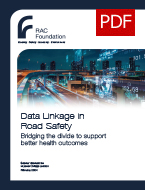Collision data and medical information sharing could lead to a better understanding of the causes and costs of road traffic collisions
Greater sharing of collision data and medical information about crash victims could lead to a much better understanding of the causes and the costs – human and financial – of death and injury on the country’s roads, and hence improve safety.
Crash and casualty data is routinely collected by the police who attend most major incidents or are at least made aware of them. It is then published by the Department for Transport through a system called STATS19.
However, to get a more rounded picture of collisions and harm on the road network this should be better linked to other sources of data, particularly injury data collected in the national medical dataset, Hospital Episode Statistics (HES), and that recorded by the ambulance service and other parties involved in the aftermath of road crashes.
Ultimately, those all those working in the road safety arena – not least those involved in health provision, law enforcement, transport policy and vehicle design – would benefit from greater data co-ordination and cross-referencing.
That is one conclusion of a report – Data Linkage in Road Safety – authored by Seema Yalamanchili, a general surgeon and a clinical research fellow at the Imperial College London Institute of Global Health Innovation, completed as part of the RTI-AID project (more information in notes to editors).
The project has been funded by the RAC Foundation and the FIA Road Safety Grant Programme, supported by the FIA Foundation.
A more co-ordinated approach would help answer some of the questions that are key to reducing road casualties and improving health outcomes, such as:
- Are the right road casualties being triaged to the right centres?
- Why do some demographic groups fare worse than others following similar collision circumstances?
- What medical interventions can be introduced to improve clinical outcomes for particular injury types?
The World Health Organisation estimates that 1.2 million people are killed annually on roads around the globe.
Europe has been relatively successful in cutting death and injury on the roads. This has been in large part down to the ‘safe system’ approach built on five pillars: safe vehicles, safe road use, safe roads, safe speeds, and post-crash response.
By 2020, the safest roads in Europe were in Norway (17 deaths per million), Sweden (20 deaths per million) and the UK (23 deaths per million).
However, 1,695 people still died on Britain’s roads in 2022 and over the past decade or so the annual number of fatalities has plateaued rather than continue to decline.
Whilst most attention is given to the number of people killed, for each fatality there is estimated to be at least five more who receive life-changing injuries putting huge pressure not just on victims and their families but also health care systems and the public finances.



